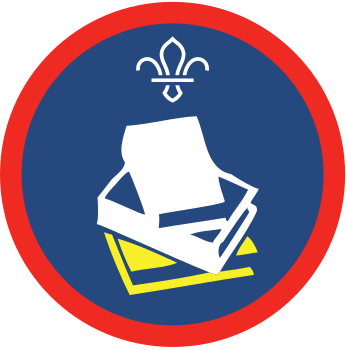
Little libraries
You’ll need
- A4 card
- Scissors
- Coloured pens or pencils
- A book you enjoyed reading
- A large container (such as a cardboard box)
Learn to love your books
Stories live forever, but if we don’t take care of the pages in which they are bound, physical and digital books can grow old before their time. Discuss the ways that we can look after books. You could structure this as small group discussions, or as a whole section ball-throwing game where young people offer suggestions for book care when they catch the ball. To help guide the conversation, it might be useful to use this list:
- Don’t throw books or e-readers around.
- Put them back on the shelf, or in a similar safe place, after reading them.
- Protect books and e-readers by making sure they aren’t left outside.
- Have clean, dry hands before reading.
- Use a bookmark instead of folding the pages of physical books.
- Keep food and drinks away from books and e-readers.
- Wipe the screen of e-readers.
- Don’t colour in or draw on physical books.
Lay the foundations
Before creating your own little library (a small collection of books to share within your section), it's useful to take a trip to your local library to learn more about the services offered there.
Libraries have much more than physical books; they often contain local archives, assist the public in accessing government schemes and funds, run early years learning programmes, and most can provide you with access to thousands of e-books, e-magazines and audiobooks.
You can find nearby libraries by popping your postcode into the government’s online searcher. Local councils and charities also run Mobile Libraries, and many schools will have a small library. You could arrange a visit in place of one of your weekly meetings, or invite a librarian along to the session you’re doing this activity in.
Stock your shelves
- Bring in a book that you would like to share with your section. If you don’t have your own copy of this book, or don’t want to lend out your copy, you could create a poster or front cover containing the title and author so that others can request it from the library. You could also look for second-hand copies at local charity shops or online.
- Your little library could be housed in anything from a used fruit and veg box (ask at your local supermarket, as they will often give these to you for free) to an old shoe rack. Make sure to choose a container that can be easily stored at your meeting place.
- Using a piece of white card, cut out a rectangle that's slightly longer than the length of your book. This can be used as a bookmark.
- Write out the title and author of the book at the top of your bookmark. Beneath this, draw or write how the book made you feel. Sign off with your name and date, and then slip this bookmark into the front of your book.
Swap stories
Your library is now open for lending. Choose a title, take it home and explore the worlds contained within it. Once you’ve finished, add your thoughts and feelings to the bookmark, sign and date it, and return the book for others to enjoy.
Reflection
This activity has taught you how to take care of your books, so that you, your friends and family can enjoy them for years to come. If you opened your own library, how would you protect your books from the wear and tear of being read by lots of different people?
How many books would you have in your library, and what genres would you include? What would your library look like? What would visitors be able to do, see, hear or make there?
Libraries function as hubs for communities. What services would people be able to access at your library, and how would you make sure that it appeals to people of different ages?
Safety
All activities must be safely managed. You must complete a thorough risk assessment and take appropriate steps to reduce risk. Use the safety checklist to help you plan and risk assess your activity. Always get approval for the activity, and have suitable supervision and an InTouch process.
- Scissors
Supervise young people appropriately when they’re using scissors. Store all sharp objects securely, out of the reach of young people.
Make it accessible
All Scout activities should be inclusive and accessible.
If you fancy building a little library that's sturdier, permanent and available for the whole community to enjoy, there are a number of step-by-step guides available on Little Free Library. This DIY project will also allow you to meet requirement 4 of your DIY Activity Badge. Remember that the books will be taken and swapped within the community, so books donated will not necessarily be returned.


